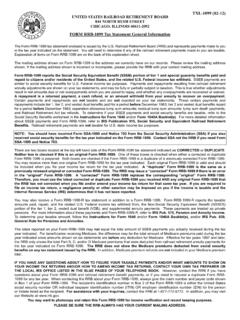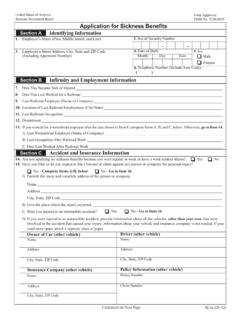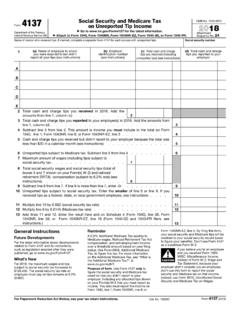Transcription of Railroad Retirement Handbook (2018) - rrb.gov
1 Railroad Retirement Board Railroad . Retirement . Handbook . 2018. Railroad Retirement Board MISSION STATEMENT. T he Railroad Retirement Board's mission is to administer Retirement /. survivor and unemployment/sickness insurance benefit programs for Railroad workers and their families under the Railroad Retirement Act and the Railroad Unemployment Insurance Act. These programs provide income protection during old age and in the event of disability, death or temporary unemployment and sickness. The Railroad Retirement Board also adminis- ters aspects of the Medicare program and has administrative responsibilities under the Social Security Act and the Internal Revenue Code. In carrying out its mission, the Railroad Retirement Board will pay ben- efits to the right people, in the right amounts, in a timely manner, and will take appropriate action to safeguard our customers' trust funds. The Railroad Retirement Board will treat every person who comes into contact with the agency with courtesy and concern, and respond to all inquiries promptly, accurately and clearly.
2 Railroad Retirement and Unemployment Insurance Systems Handbook Railroad Retirement Board 844 North Rush Street Chicago, Illinois 60611-1275. INTRODUCTION. T. his publication describes the history, operations and financing of the Retirement , disability, survivor, and health insurance programs provided under Federal law for Railroad workers and their families, as well as the unemployment and sickness insurance program provided for Railroad employees. For many years this book has been utilized by officials of railway management, rail labor, government and beneficiaries, as well as by students of social insurance programs and pension systems. It was designed to provide a convenient reference for those requiring a compre- hensive single source of information on the development and character of the Railroad Retirement /survivor and unemployment/sickness benefit programs. This edition reflects the laws in effect as of August 2018. Certain limitations, exceptions and special cases are not covered.
3 Further infor- mation may be obtained by contacting the Railroad Retirement Board toll- free at 1-877-772-5772 or by visiting the agency's website at We trust that this book will continue to serve as an authoritative and useful source of information on the Railroad Retirement and unem- ployment insurance systems. Steven J. Anthony Walter A. Barrows Management Member Labor Member CONTENTS. Page 1 DEVELOPMENT OF THE Railroad Retirement SYSTEM 1. Railroad Retirement Acts of the 1930s .. 1. Amendments to the 1937 Act .. 2. Railroad Retirement Act of 1974 .. 5. 1981 Railroad Retirement Amendments .. 6. Railroad Retirement Solvency Act of 1983 .. 7. Legislation Enacted 1985-2000 .. 9. The Railroad Retirement and Survivors' Improvement Act of 2001 .. 10. Court Decisions, Legislation Enacted 2006-2015 .. 12. 2 PROVISIONS OF THE Railroad Retirement ACT 15. Creditable Service and Earnings .. 15. Employee and Spouse Annuities .. 17. Survivor Benefits.
4 26. Retirement -Survivor Information .. 30. Employee and Spouse Annuity Formula Components .. 36. Survivor Annuity Formula Components .. 41. Appeals .. 43. 3 FINANCING OF THE Railroad Retirement SYSTEM 45. Payroll Taxes .. 45. Financial Interchange .. 46. Investments .. 47. Borrowing from General Revenues Related to the Financial Interchange.. 48. Appropriations from General Revenues .. 48. Taxation of Railroad Retirement Benefits .. 50. Financial Position of the Railroad Retirement System .. 50. 4 HEALTH INSURANCE FOR THE AGED AND DISABLED 51. Eligibility .. 51. Part A and Part B Enrollment .. 52. Explanation of Hospital Insurance Benefits .. 53. Explanation of Medical Insurance Benefits .. 54. Medicare Plan Choices .. 55. Medicare Prescription Drug Coverage .. 57. Appeals .. 57. Advance Directives .. 58. Medicare Publications .. 58. Toll-Free Numbers/Websites .. 58. Page 5 DEVELOPMENT OF THE Railroad UNEMPLOYMENT INSURANCE SYSTEM 59.
5 Railroad Unemployment Insurance Act of 1938.. 59. Major Amendments to the Railroad Unemployment Insurance Act .. 59. 1988 Legislation and Later Amendments.. 62. 6 PROVISIONS OF THE Railroad UNEMPLOYMENT INSURANCE ACT 65. Benefit Provisions .. 65. Payment Process .. 69. Appeals .. 71. Income Taxes .. 72. 7 FINANCING UNEMPLOYMENT AND SICKNESS INSURANCE 73. Contributions .. 73. Railroad Unemployment Insurance Account .. 74. Financial Report .. 76. 8 ADMINISTRATION OF THE Railroad Retirement SYSTEM 77. Administration .. 77. Keeping Beneficiaries Informed .. 79. Program Integrity .. 80. Office of Inspector General .. 80. INDEX .. 82. 1. DEVELOPMENT OF THE. Railroad Retirement SYSTEM. P. tem which would continue and broaden the rivate pension plans originated in existing Railroad programs under a uniform the Railroad industry in 1874 when national plan. The proposed social security the first formal industrial pension system was not scheduled to begin monthly plan in North America was established.
6 By benefit payments for several years and would 1927, over 80 percent of all Railroad employ- not give credit for service performed prior to ees in the United States worked for employ- 1937, while conditions in the Railroad indus- ers who had formal plans in operation, but try called for immediate benefit payments only a small proportion of the employees ever based on prior service. received benefits under these plans. The pen- sion plans had a number of serious defects. Legislation was enacted in 1934, 1935. They generally paid inadequate benefits and and 1937 to establish a Railroad Retirement had limited provisions for disability retire- system separate from the social security ment. Credits could not be transferred freely program legislated in 1935. Such legisla- from employer to employer, and the employ- tion, taking into account the particular ers could terminate the plans at will. With circumstances of the rail industry, was not few exceptions, the plans were inadequately without precedent.
7 Numerous laws pertain- financed and could not withstand even tem- ing to rail operations and safety had already porary difficulties. been enacted since the Interstate Commerce Act of 1887. Since passage of the Railroad The Great Depression of the early 1930s Retirement Acts of the 1930s, numerous led to movements for Retirement plans on other Railroad laws have subsequently been a national basis because few of the nation's enacted. elderly were covered under any type of retire- ment plan. Railroad employees were particu- larly concerned because the private Railroad Railroad Retirement ACTS. pension plans could not keep up with the OF THE 1930s demands made upon them by the general deterioration of employment conditions and The Railroad Retirement Act of 1934 set by the great accumulation of older workers in up the first Retirement system for nongovern- the industry. While the social security system mental workers in this country to be admin- was in the planning stage, Railroad workers istered by the Federal Government.
8 How- sought a separate Railroad Retirement sys- ever, the Act was declared unconstitutional 1. Railroad Retirement Handbook , 2018. by a Federal district court, and this decision mum of $300 a month, while no more than was sustained by the Supreme Court. The 30 years of service could be credited when Railroad Retirement and Carriers' Taxing service before 1937 was counted. Annuities Acts of 1935 were enacted to avoid the consti- could be paid at age 65 or later, regardless tutional difficulties encountered by the 1934 of length of service, or at ages 60-64 (on a Act. However, these Acts were also chal- reduced basis) after 30 years of service. lenged in the courts, and a Federal district The conditions for paying annuities court held that neither the employees nor based on disability were severely restricted. their employers could be compelled to pay The disability had to be total and 30 years Railroad Retirement taxes. The court, howev- of service were required for full annuities.
9 Er, did not prohibit the payment of benefits, Employees could receive disability annuities and the Railroad Retirement Board (RRB) at ages 60-64 after less than 30 years of ser- began awarding annuities in July 1936 under vice, but on a reduced basis. the provisions of the 1935 Act. The Act made little provision for depen- While an appeal was pending, Railroad dents of deceased employees and no provision management and labor, at the request of for spouse annuities. A survivor could receive President Roosevelt, formed a joint commit- a lump sum equal to 4 percent of the employ- tee to negotiate their differences. The result ee's creditable earnings after 1936, less any was a memorandum of agreement which led annuity payments already made. In addition, to the Railroad Retirement and Carriers' a retiring employee could elect to receive a Taxing Acts of 1937 establishing the Railroad reduced annuity in order to provide an annu- Retirement system.
10 The pensions of retired ity to his surviving spouse. employees on the railroads' private pension The system was financed by a schedule rolls were transferred to the RRB's rolls with of taxes beginning with percent each on pension reductions restored. The benefit employers and employees applicable to the payments of almost 50,000 pensioners were first $300 of monthly compensation. taken over by the RRB in July 1937. There followed an immediate reduction in both the number of employed and unemployed older AMENDMENTS TO THE 1937 ACT. Railroad workers. By the end of 1938, the number of workers age 65 and over in active Numerous amendments after 1937. Railroad service was less than one-half of the increased benefits and added, to what began number two years earlier. Almost 100,000 as a staff Retirement system, social insurance employees had retired under the system by features similar to those provided by the that date, 80 percent of them under the non- social security system.











